
London, a city with a population of 8.6 million, is set to become a bike city. The city authorities have plans to invest around 1.3 billion euros in infrastructure and political initiatives to quadruple bicycle traffic. The plans include a 23-mile network of cycle highways, called “Cycle Superhighways,” with quieter “Quietways” and more than 10,000 rental bicycles. According to a study, the number of inner-city bike trips already rose by 133 percent between 2000 and 2015, reaching 670,000 daily. eBikes may become an important factor here in the future. On its website, Transport for London gives eBikes the thumbs up for their suitability for commuting, environmental friendliness, speed and performance.
A change in attitudes is vital. Already more than 50 percent of the world's population lives in cities. This figure will have risen to 75 percent by 2050. The city is the living concept for the future. Ideas are developed in these dynamic centers. This is where change is initiated. This is where trends are set. However, cities also face a number of big challenges: air pollution, water and energy supply shortages, lack of space, and congested streets. The list goes on and solutions are badly needed.
Electromobility can make a contribution to sustainable city development and a liveable urban environment. eBikes in particular offer enormous opportunities as a means of transport. They help save resources as well as reduce emissions and noise. In Copenhagen, the undisputed bicycle capital of the world, 63 percent of residents now cycle to work or school. Only nine percent use cars. Since the 1970s, parking space for cars has been consistently reduced at a rate of three percent year on year in order to provide more space for bicycles.

The German government is also increasingly moving towards pedal power. The “National Cycling Plan 2020” was launched four years ago. The idea: to make cycling more attractive to people by means of a comprehensive package of measures and improved infrastructure, particularly for commuting to work. The government aims to increase the proportion of cycle traffic to 15 percent by 2020 (currently 12 percent). But are the measures being implemented sufficient? Although the political will exist to promote more bicycle traffic, things are not developing as hoped, according to the ADFC (General German Bicycle Club) for example.
The ADFC points to the Netherlands as model. Cycling has been massively encouraged there since the 1980s and bicycles now represent a 27 percent share of all traffic. This is thanks, for example, to access restrictions for cars, higher parking charges and, above all, an integrated network of cycle paths. Ever more charging stations and secure parking facilities are also currently being built.
A study has shown that most car commuters in Germany could also switch to bikes. After all, 82 percent of commuters in the country cover less than 16 miles on their daily commute to work, while one in two travels less than 6 miles to work. These distances do not pose any problem, especially by eBike.

It is important to cycling commuters that cycle paths be sufficiently safe and attractive. For example so-called protected bike lanes, i.e. wide cycle paths along the main traffic routes, physically separated from cars and exclusively dedicated to cyclists. If all of these elements are in place, the motivation to switch to bicycles like the eBike comes naturally, as London-based computer analyst Julia explains: “I do it for purely practical reasons. It helps me keep fit and saves money. The underground is expensive,” explains the fortysomething German. It is also a good way to break up the day, she explains, “I get to work feeling better when I travel by eBike and I'm somehow more relaxed when I get home again in the evenings.”
So it's not just about saving time and money, but also about quality of life and health: The fact is that the average adult spends 11.5 hours every day sitting down. People don't get enough exercise, particularly if they have an office job. eBikes are perfect for commuters who want to increase their stamina and fitness as an incidental benefit.

Moreover, people who opt for an eBike instead of a car are benefiting not just themselves, but also the environment. Based on an average fuel consumption of eight litres per 62 miles for all commuter cars in Germany, this yields a consumption of almost 70 million liters of petrol per day. This results in 156,000 tons of CO2. eBikes therefore offer enormous savings potential. And this is becoming more and more important because the city as the center of life and as a meeting place is increasingly becoming the center of focus. The reason for this is that we are all rediscovering our cities.
“Competing with the car”
Boris Palmer is the Mayor of Tübingen and
“Germany's most bicycle-friendly person of 2015”
You use an eBike to get to work. Why?
At first, I tried travelling by car, but after two years I decided to get rid of it. I replaced it with a Speed eBike. It's the fastest way to get around the city, I'm in the fresh air and can even get some exercise if I want. In Tübingen, a city with seven hills and an altitude differential of 124 miles, I also need to be able to get about in a suit without breaking into a sweat. In winter I sometimes take the bus.
How many miles do you cover by bike each year?
1,243 miles by Speed & Bike and up to 2,485 miles by conventional bike.
Ten years ago, Tübingen approved a plan to reduce CO2 emissions by 70 percent. Where are you today?
We've reached 25 percent - a good level for Germany. But it's not enough.
You're an advocate of the high-speed eBike. Is there a particular reason for this?
Look at what eBikes are mostly used for: leisure. This is because commuting distances have grown and that it takes too long to cover ten kilometres at a maximum speed of 16 miles per hour. The Speed eBikes allows you to compete with the car. Out of town, you can travel at 35 to 22 to 25 miles per hour, you don't have to look for a parking space and you'll be at least as fast as a car. That's what we really need. Persuading commuters to switch from their cars to suburban train services is expensive and takes decades. Speed & Bikes could solve the problems overnight. Bringing commuting by bike up to speed: that's my objective!